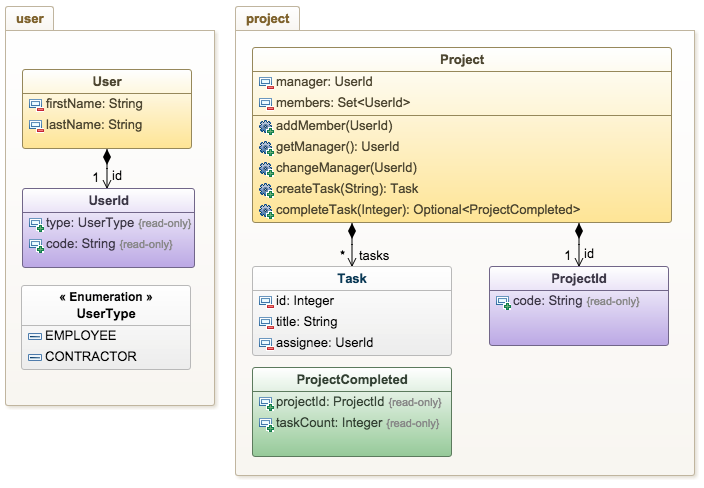Tutorial
This tutorial will guide you step-by-step in building a full application with SeedStack business framework.
To use it, the following dependency must be present in your POM:
<dependency>
<groupId>org.seedstack.business</groupId>
<artifactId>business-core</artifactId>
</dependency>dependencies {
compile("org.seedstack.business:business-core:4.5.0")
}The domain: software project management
For the sake of the tutorial, let’s pretend that we have to solve the problem of managing software projects.
- Projects are created
- A project is picked according to some business criteria,
- A project is assigned a project manager,
- The project manager organizes the team,
- The project manager organizes the sprints.
Step 1: the domain model
We are not going into the details of how to elaborate a great domain model because it needs business insight and an iterative process. Here is a simplistic model for this domain:

In this model we can note that:
- Object state can only be changed through business-meaningful methods.
- Immutable value objects (in violet) are extensively used,
- Those value objects and entities are grouped into aggregates that share a common lifecycle.
- A domain event (in green) is defined.
The user aggregate
In the domain.model package, create a subpackage named user. Inside this package create a UserType enum:
package org.generated.project.domain.model.user;
public enum UserType {
EMPLOYEE,
CONTRACTOR
}
Then create the UserId value object:
package org.generated.project.domain.model.user;
import org.seedstack.business.domain.BaseValueObject;
public class UserId extends BaseValueObject {
private final UserType type;
private final String code;
public UserId(UserType type, String code) {
this.type = type;
this.code = code;
}
public String asString() {
return (type == UserType.EMPLOYEE ? "E" : "C") + code;
}
}
And finish the aggregate with the User aggregate root:
package org.generated.project.domain.model.project;
import org.seedstack.business.domain.BaseAggregateRoot;
public class User extends BaseAggregateRoot<UserId> {
private final UserId id;
private final String firstName;
private final String lastName;
public User(UserId id, String firstName, String lastName) {
this.id = id;
this.firstName = firstName;
this.lastName = lastName;
}
public String getFirstName() {
return firstName;
}
public String getLastName() {
return lastName;
}
}
The project aggregate
In the domain.model package, create a subpackage named project. Inside this package create a ProjectId value object:
package org.generated.project.domain.model.project;
import org.seedstack.business.domain.BaseValueObject;
public class ProjectId extends BaseValueObject {
private final String code;
public ProjectId(String code) {
this.code = code;
}
public String getCode() {
return this.code;
}
}
Then create the Task entity:
package org.generated.project.domain.model.project;
import org.seedstack.business.domain.BaseEntity;
public class Task extends BaseEntity<Integer> {
private final Integer id;
private final String title;
private boolean completed;
public Task(int id, String title) {
this.id = id;
this.title = title;
}
public boolean isCompleted() {
return this.completed;
}
void markCompleted() {
this.completed = true;
}
}
Now, let’s create the ProjectCompleted domain event:
package org.generated.project.domain.model.project;
import org.seedstack.business.domain.BaseDomainEvent;
public class ProjectCompleted extends BaseDomainEvent {
private final ProjectId projectId;
private final int taskCount;
public ProjectCompleted(ProjectId projectId, int taskCount) {
this.projectId = projectId;
this.taskCount = taskCount;
}
public ProjectId getProjectId() {
return projectId;
}
public int getTaskCount() {
return taskCount;
}
}
And finish the aggregate with the Project aggregate root:
package org.generated.project.domain.model.project;
import java.util.HashMap;
import java.util.HashSet;
import java.util.Map;
import java.util.Optional;
import java.util.Set;
import org.generated.project.domain.model.user.UserId;
import org.seedstack.business.domain.BaseAggregateRoot;
public class Project extends BaseAggregateRoot<ProjectId> {
private final ProjectId id;
private UserId managerId;
private Set<UserId> members = new HashSet<>();
private Map<Integer, Task> tasks = new HashMap<>();
private int maxTaskId = 0;
public Project(ProjectId id) {
this.id = id;
}
public void addMember(UserId memberId) {
members.add(memberId);
}
public UserId getManager() {
return managerId;
}
public void changeManager(UserId managerId) {
// We ensure that the manager is always a member of the project
if (!members.contains(managerId)) {
members.add(managerId);
}
this.managerId = managerId;
}
public Task createTask(String title) {
// This factory method generate an identity for the new task
Task task = new Task(++maxTaskId, title);
tasks.put(task.getId(), task);
return task;
}
public Optional<ProjectCompleted> completeTask(int taskId) {
Task task = tasks.get(taskId);
if (task == null) {
throw new IllegalArgumentException("Unable to find task number " + taskId);
}
// The package-private method is not accessible outside the aggregate
task.markCompleted();
if (tasks.values().stream().allMatch(Task::isCompleted)) {
return Optional.of(new ProjectCompleted(id, tasks.size()));
} else {
return Optional.empty();
}
}
}

 Maven
Maven Gradle
Gradle